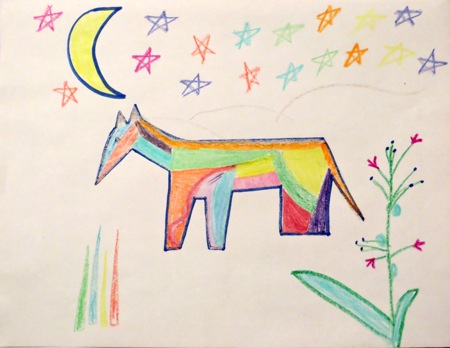2. The Second World
Because of the strife in the First World, First Man, First Woman, the Great-Coyote-Who-Was-Formed-in-the-Water, and the Coyote called First Angry, followed by all the others, climbed up from the First World, the World of Darkness and Dampness, to the Second World, Ni’hodotl’ish, or the Blue World.
When they came to the Second World, they found a number of people already living there: Bluebirds, Blue Hawks, Blue Jays, Blue Herons, and all the blue-feathered beings.
The powerful Swallow People lived there also, and these people made the Second World unpleasant for those who had come from the First World. There was fighting and killing.
The First Four found an opening in the World of Blue Haze; and they climbed through this and led the people up into the Third or Yellow World.

Above: Illustration of First Angry Coyote, drawn by a child in the UUCPA Sunday school after seeing images of Navajo rugs and sand paintings.
3. Arriving in the Third World
The Bluebird was the first to reach the Third or Yellow World. After him came the First Four and all the others.
A great river crossed this land from north to south. It was the Female River.
There was another river crossing it from east to West, it was the Male River. This Male River flowed through the Female River and on; and the name of this place is Tqo alna’osdli, the Crossing of the Waters.
There were six mountains in the Third World. In the East was Sis na’ jin, the Standing Black Sash. Its ceremonial name is Yolgai’dzil, the Dawn or White Shell Mountain. In the South stood Tso’dzil, the Great Mountain, also called Mountain Tongue. Its ceremonial name is Yodolt i’zhi dzil, the Blue Bead or Turquoise Mountain. In the West stood Dook’oslid, and the meaning of this name is forgotten. Its ceremonial name is Dichi’li dzil, the Abalone Shell Mountain. In the North stood Debe’ntsa, Many Sheep Mountain. Its ceremonial name is Bash’zhini dzil, Obsidian Mountain. Then there was Dzil na’odili, the Upper Mountain. It was very sacred; and its name means also the Center Place, and the people moved around it. Its ceremonial name is Ntl’is dzil, Precious Stone or Banded Rock Mountain. There was still another mountain called Chol’i’i or Dzil na’odili choli, and it was also a sacred mountain.
There was no sun in this land, only the two rivers and the six mountains. And these rivers and mountains were not in their present form, but rather the substance of mountains and rivers as were First Man, First Woman, and the others.
Now beyond Sis na’ jin, in the east, there lived the Turquoise Hermaphrodite [Turquoise Boy], Ashton nutli, who was then neither a boy nor a girl. Later he was also known as the Turquoise Boy. And near this person grew the male reed. Beyond, still farther in the east, there lived a people called the Hadahuneya’nigi, the Mirage or Agate People. Still farther in the east there lived twelve beings called the Naaskiddi. And beyond the home of these beings there lived four others — the Holy Man, the Holy Woman, the Holy Boy, and the Holy Girl.
In the West there lived the White Shell Hermaphrodite, who was then neither boy nor girl; later she became White Shell Girl, and still later she entered the Moon and became Moon Bearer. And with her was the big female reed which grew at the water’s edge. It had no tassel. Beyond her in the West there lived another stone people called the Hadahunes’tqin, the Ground Heat People. Still farther on there lived another twelve beings, the Corn Maidens, all of whom were females. And again, in the Far West, there lived four Holy Ones.
Within this land there lived the Kisa’ni, the ancients of the Pueblo People. On the six mountains there lived the Cave Dwellers or Great Swallow People. The Great Swallow People lived in rough houses of mud and sticks. They entered them from holes in the roof. On the mountains lived also the light and dark squirrels, chipmunks, mice, rats, the turkey people, the deer and cat people, the spider people, and the lizards and snakes. The beaver people lived along the rivers, and the frogs and turtles and all the underwater people in the water. So far all the people were similar. They had no definite form, but they had different names because they were different inside.
Now the plan was to plant. First Man called people together. He brought forth the white corn which had been formed with him. First Woman brought the yellow corn. They laid the perfect ears side by side; then they asked one person from among the many to come and help them. The Turkey stepped forward. They asked him where he had come from, and he said that he had come from the Gray Mountain. The Gray Mountain is the home of the Gray Yei, Hasch ei’ba’i, whose other name is Water Sprinkler. The turkey is connected with water and rain.
The Turkey danced back and forth four times, then he shook his feather coat and there dropped from his clothing four kernels of corn, one gray, one blue, one black, and one red. Another person was asked to help in the plan of the planting. The Big Snake came forward. He likewise brought forth four seeds, the pumpkin, the watermelon, the cantaloupe, and the muskmelon. His plants all crawl on the ground.
They planted the seeds, and their harvest was great.
This version of the Diné bahané is adapted from a public domain source edited by Aileen O’Bryan, The Dîné: Origin Myths of the Navaho Indians, Bulletin 163 of the Bureau of American Ethnology of the Smithsonian Institution, (1956), pp. 1-13. To read part one, click here.
